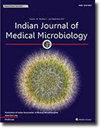Occult hepatitis B virus infection among chronic liver disease patients: Insights from a tertiary care hospital
IF 1.4
4区 医学
Q4 IMMUNOLOGY
引用次数: 0
Abstract
Purpose
Occult hepatitis B virus (HBV) infection (OBI) is a often overlooked contributor to chronic liver disease (CLD). This study aimed to determine the occurrence of OBI among CLD patients, assessing the presence of HBV DNA in HBsAg-negative individuals and exploring associated risk factors and clinical implications.
Methods
A cross-sectional study was conducted at the Pondicherry Institute of Medical Sciences, enrolling 169 CLD patients who tested negative for HBsAg. Blood samples were collected and analyzed for anti-HBc antibodies using the VIDAS anti-HBc total ELFA kit (BIOMERIEUX). HBV DNA was detected using real-time PCR with the Qiagen Artus HBV PCR kit. Demographic, clinical, and laboratory data were recorded to identify risk factors and disease patterns.
Results
A total of 169 HBsAg negative chronic liver disease (CLD) patients were evaluated. Anti-HBc positivity was observed in 32 % (54/169), OBI was identified in 5.3 % (9 out of 169) of patients, characterized by concurrent presence of anti-HBc antibodies and detectable HBV DNA. OBI cases were exclusively male and primarily in 41–60-year age group. Clinical features and biochemical parameters did not differ significantly between OBI and non-OBI groups. Blood transfusion history was the only risk factor significantly associated with OBI (p = 0.04). HBV DNA-positive patients showed elevated liver enzymes, indicating ongoing hepatic injury.
Conclusions
Occult hepatitis B infection (OBI) was detected in 5.3 % of HBsAg-negative chronic liver disease (CLD) patients, primarily among middle-aged males. The findings emphasize the limitations of routine serological testing and advocate for the inclusion of anti HBc screening and HBV DNA testing, particularly in patients with prior blood transfusions. Early identification of OBI is crucial for appropriate clinical management and may help prevent further progression of liver disease in this high-risk group.
慢性肝病患者隐匿性乙型肝炎病毒感染:来自三级医院的见解。
目的:隐匿性乙型肝炎病毒(HBV)感染(OBI)是慢性肝病(CLD)的一个经常被忽视的因素。本研究旨在确定CLD患者中OBI的发生,评估hbsag阴性个体中HBV DNA的存在,并探讨相关的危险因素和临床意义。方法:在本地治里医学科学研究所进行了一项横断面研究,招募了169名HBsAg阴性的CLD患者。采集血样并使用VIDAS抗hbc总ELFA试剂盒(BIOMERIEUX)分析抗hbc抗体。采用Qiagen Artus HBV PCR试剂盒实时PCR检测HBV DNA。记录了人口统计学、临床和实验室数据,以确定危险因素和疾病模式。结果:共对169例HBsAg阴性的慢性肝病(CLD)患者进行评估。抗hbc阳性患者占32% (54/169),OBI患者占5.3%(169 / 9),其特征是同时存在抗hbc抗体和可检测的HBV DNA。OBI病例全部为男性,主要发生在41-60岁年龄组。临床特征和生化指标在OBI组和非OBI组之间无显著差异。输血史是唯一与OBI显著相关的危险因素(p = 0.04)。HBV dna阳性患者显示肝酶升高,表明肝损伤正在进行。结论:隐匿性乙型肝炎感染(OBI)在5.3%的hbsag阴性慢性肝病(CLD)患者中检测到,主要发生在中年男性中。研究结果强调了常规血清学检测的局限性,并提倡纳入抗HBc筛查和HBV DNA检测,特别是在有输血史的患者中。早期识别OBI对于适当的临床管理至关重要,并可能有助于预防这一高危人群肝脏疾病的进一步发展。
本文章由计算机程序翻译,如有差异,请以英文原文为准。
求助全文
约1分钟内获得全文
求助全文
来源期刊

Indian Journal of Medical Microbiology
IMMUNOLOGY-
CiteScore
2.20
自引率
0.00%
发文量
154
审稿时长
73 days
期刊介绍:
Manuscripts of high standard in the form of original research, multicentric studies, meta analysis, are accepted. Current reports can be submitted as brief communications. Case reports must include review of current literature, clinical details, outcome and follow up. Letters to the editor must be a comment on or pertain to a manuscript already published in the IJMM or in relation to preliminary communication of a larger study.
Review articles, Special Articles or Guest Editorials are accepted on invitation.
 求助内容:
求助内容: 应助结果提醒方式:
应助结果提醒方式:


